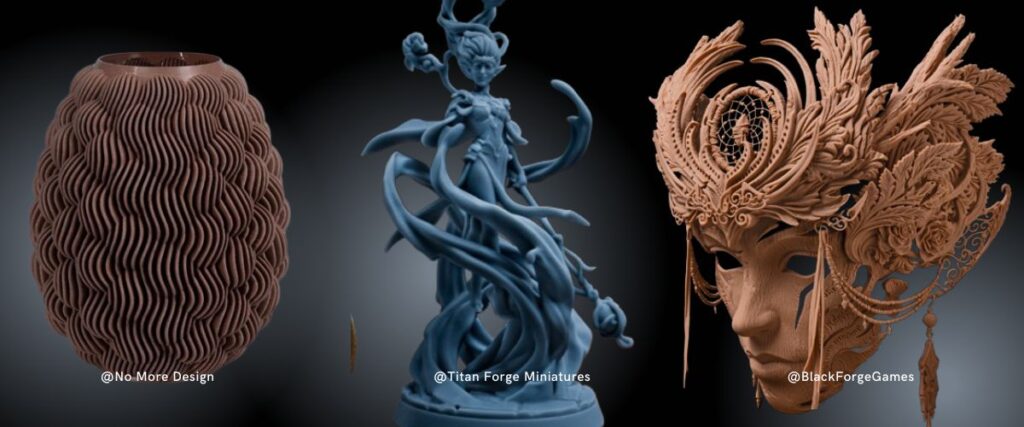Selling physical 3D prints can be rewarding, but it also comes with high costs, time constraints, and limited scalability. What if you could make money from your 3D designs without worrying about production? The solution? Selling STL files instead!
By creating and selling digital 3D models, you can earn passive income with 3D printing—without ever touching a printer. No material costs, no shipping headaches—just pure profit. Ready to get started? This guide will show you how to sell 3D models online and turn your designs into a scalable business.
Why Selling STL Files Is More Profitable
If you’ve been selling physical 3D prints, you already know the challenges: material costs, printer maintenance, long print times, and shipping hassles. While selling physical prints can be profitable, it’s time-consuming and limits your earning potential. That’s where selling digital 3D models comes in—it allows you to make money with zero production costs and unlimited scalability.
Here’s why switching to selling STL files is a smarter move:
No Production Costs
One of the biggest downsides of selling physical 3D prints is the cost of materials. Filament, resin, and electricity all add up, cutting into your profits. Plus, you need a high-quality 3D printer and regular maintenance to keep it running smoothly. When you sell STL files, you eliminate these costs entirely—your only investment is your design software and creativity.
Unlimited Scalability
When you sell physical prints, your earnings are limited by how much you can print and ship. But selling 3D model files is different. You create the design once and sell it endlessly, generating passive income with 3D printing. There’s no cap on how many times you can sell a single STL file, making this business infinitely scalable.
Shipping physical products can be a headache, especially if you’re dealing with international customers. Shipping delays, high costs, and customs issues can frustrate buyers and cut into your profit margins. Selling digital 3D models solves this problem—you can sell to anyone, anywhere instantly through an STL marketplace like PIXUP.
No More Failed Prints – Sell with Confidence
Anyone who has used a 3D printer knows the frustration of failed prints. A small mistake—whether in the design, slicing settings, or printer calibration—can ruin an entire project, wasting time, materials, and money. When you sell STL files instead of physical prints, you let the buyer handle the printing, eliminating the stress of misprints, broken supports, and print failures.
But here’s the catch: buyers still want assurance that the STL files they purchase will print flawlessly. That’s where quality control matters. If you want to stand out as a seller and build a reputation for reliable, print-ready designs, consider getting your models approved through Phrozen-Verified. This program ensures that your STL files are tested and optimized for flawless printing, giving buyers more confidence in their purchases.
By ensuring your designs are optimized and print-ready, you create a better experience for buyers, boost your reputation, and reduce post-sale issues, making your STL-selling business even more scalable and profitable.
If you want to turn 3D printing into a side hustle, check out this guide on 3d-printing side hustle.
How to Start Selling STL Files: Step-by-Step Guide
Selling STL files isn’t just about designing models and listing them online—it’s about choosing the right niche, ensuring quality, and leveraging the best platforms to maximize your sales. Follow this step-by-step guide to sell 3D model files successfully and turn your digital designs into a scalable income stream.
Step 1: Choose a Profitable 3D Model Niche
Not all 3D models sell equally well. Some niches are highly competitive, while others have strong demand and limited supply. To succeed in selling 3D digital files, focus on profitable, high-demand categories that attract buyers:
Tabletop Gaming Miniatures & Figurines – A High-Demand Niche
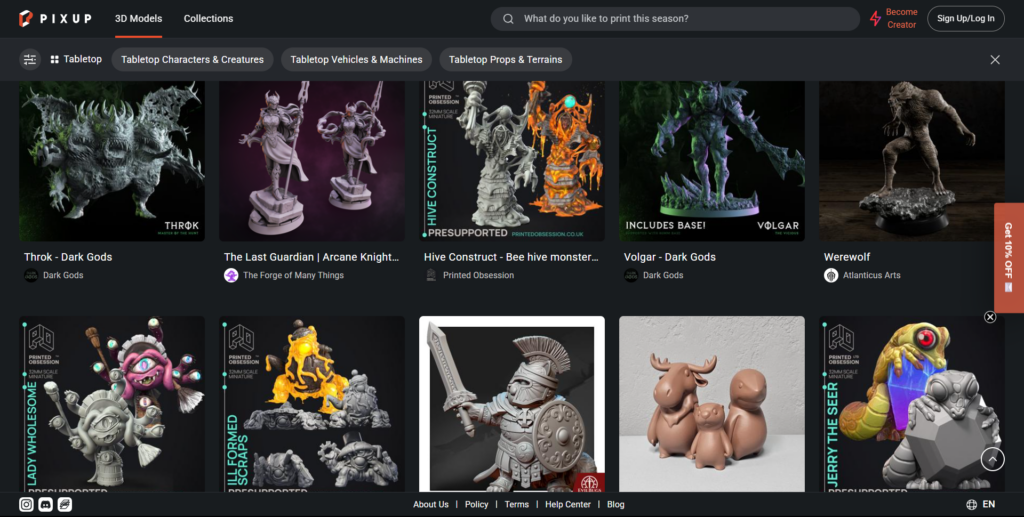
Image source: PIXUP
The tabletop gaming market is booming, valued at $20.8 billion in 2023 and projected to grow to $35.3 billion by 2030, according to Strategic Market Research. Miniature wargames and RPG figurines are among the fastest-growing segments, driven by the rising popularity of Dungeons & Dragons (D&D), Warhammer, and other strategy-based games.
With the rise of crowdfunding platforms like Kickstarter, massive projects like Frosthaven ($13M raised) prove that players are willing to invest in high-quality miniatures and terrain. This demand creates a profitable opportunity for designers to sell STL files for:
- Custom miniatures & RPG characters
- D&D accessories & terrain (battle maps, dice towers, modular dungeons)
- Wargaming figurines & sci-fi battle units
Since the RPG market is growing at a CAGR of 10.2%, now is the perfect time to sell 3D model files in this niche. If you want to stand out, consider submitting your designs for Phrozen-Verified approval on PIXUP to attract serious buyers looking for print-tested miniatures.
Cosplay Props & Wearable Armor – A Growing Opportunity for 3D Designers
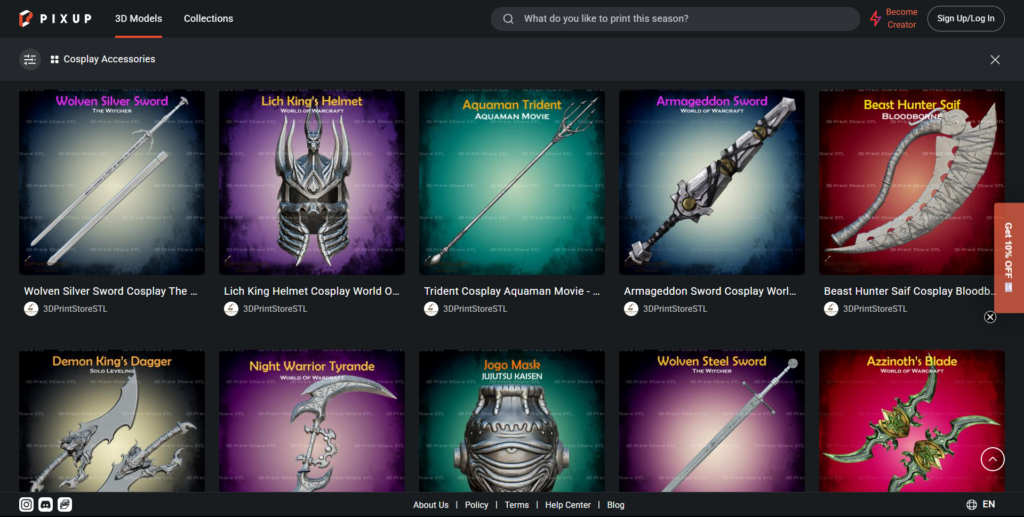
Image source: PIXUP
The cosplay industry has exploded in popularity, fueled by anime, gaming, and blockbuster franchises. With major events like Comic-Con and Anime Expo attracting millions of attendees, the demand for high-quality, custom cosplay props and armor is at an all-time high.
Many cosplayers prefer 3D printing their props instead of handcrafting them, making STL files for helmets, armor sets, weapons, and accessories a lucrative market for 3D designers. Iconic designs from movies, anime, and video games consistently sell well, especially for:
- Full-scale helmets and masks (Star Wars, Halo, anime-inspired designs)
- Wearable armor sets (medieval, sci-fi, fantasy)
- Weapons & accessories (lightsabers, swords, futuristic guns)
Since customization is key in cosplay, selling STL files allows buyers to resize, modify, and print their props to fit their needs—giving 3D designers a competitive advantage. By offering original, detailed, high-quality designs, you can tap into this thriving market and sell 3D model files to a passionate, ever-growing community.
Useful Household Gadgets – A Profitable Niche for 3D Printing
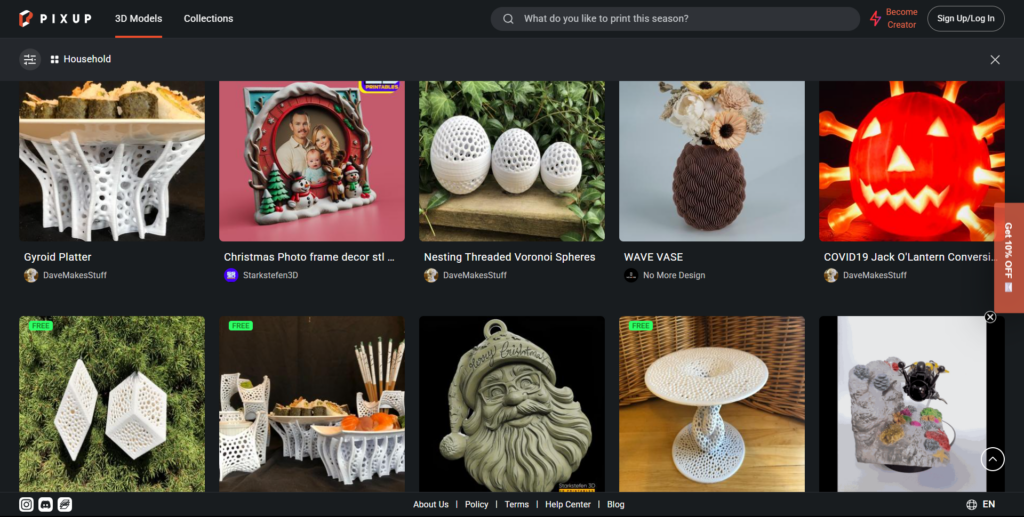
The personalized home decor market is expanding rapidly, projected to reach $330.6 billion by 2034, driven by a CAGR of 7.2%. Consumers are shifting away from mass-produced products, favoring custom, space-saving, and multifunctional designs that enhance both aesthetics and functionality.
For 3D designers, this presents a lucrative opportunity to sell STL files for practical home accessories that cater to the demand for modular, customizable, and eco-friendly designs.
Popular 3D-printable household gadgets include:
- Kitchen organizers (spice racks, utensil holders, storage solutions)
- Cable management accessories (clips, organizers, phone stands)
- Plant pots and home decor (self-watering planters, modular shelving)
- Space-saving solutions (wall hooks, stackable storage, smart home accessories)
With sustainability becoming a key market driver, 3D-printed home accessories align with eco-conscious trends by minimizing material waste and offering reusable, customizable solutions.
As more consumers embrace personalized home decor, selling digital 3D models for functional household items provides a scalable and profitable business opportunity.
Need more inspiration? Check out this blog on the best things to 3D print and sell to discover what’s currently trending!
Step 2: Create High-Quality STL Files
If you want to sell STL files successfully, quality is everything. Buyers expect clean, error-free models that print smoothly without requiring modifications.
Poorly optimized designs lead to failed prints, bad reviews, and lost sales, so it’s essential to follow best practices when creating digital 3D models for sale.
Use Professional Software
Your choice of 3D modeling software significantly impacts the quality and complexity of your designs. Whether you’re creating high-detail miniatures, wearable cosplay armor, or functional household gadgets, using the right tools ensures precise geometry and optimized printability.
Popular software options include:
Fusion 360
Price: Free for personal use,$680/year for commercial.
A cloud-based 3D CAD software with powerful tools for parametric modeling, sculpting, and assemblies. It’s ideal for functional designs like mechanical parts, gears, and brackets, but also supports organic modeling using T-Splines.
Fusion 360 allows you to edit, optimize, and export STL files, making it a great choice for creating and refining 3D models before selling. It also supports direct 3D printing and mesh editing, useful for modifying scans or existing models.
Blender
Price: It’s a free, open-source.
A powerful polygon-based 3D modeling software best for sculpting, animation, and artistic designs. While not built for solid modeling, Blender excels at creating highly detailed, organic models like miniatures, characters, and decorative STL files.
It includes photorealistic rendering, making it great for showcasing products before selling. However, it has a steep learning curve and is best suited for those ready to master complex modeling techniques.
ZBrush
Price: $39.95/month to $895.
The go-to software for sculpting highly detailed organic models, making it perfect for miniatures, characters, and intricate designs. ZBrush can handle millions of polygons while keeping file sizes optimized for 3D printing.
The 3D Print Hub feature simplifies STL preparation by fixing issues like wall thickness and supports. While it has a steep learning curve and differs from traditional CAD software, it offers unmatched sculpting precision for those focused on artistic, high-detail STL files.
Aside from these three software, there are other great ones that you might want to check out, such as Tinkercad, SketchUP, 3D Slash, Wings3D, etc.
Tip: Learn the best modeling techniques for STL file optimization to avoid errors and ensure smooth printing.
Test Your Models Before Selling
A well-designed STL file should be 100% printable without requiring manual repairs. Run a test print before listing your model for sale to check for:
- Structural weaknesses – Thin walls or unsupported overhangs can cause print failures.
- Support placement – Ensure necessary supports are in place without excessive material usage.
- File integrity – Use tools like Netfabb or Meshmixer to detect and fix non-manifold geometry, holes, or intersecting faces.
Tip: Many buyers aren’t experts in 3D printing, so providing pre-supported versions of your models can boost sales.
Offer Multiple File Formats
While STL is the most common format, offering additional file types can expand your customer base. Some users may prefer:
- OBJ – Keeps color and texture data (useful for AR/VR applications and rendering).
- 3MF – A newer format that stores print settings and metadata for better reliability.
- STEP/IGES – Used in engineering and CAD-based models.
Providing multiple formats increases model compatibility across different slicers and 3D printing workflows.
Provide High-Quality Previews
Buyers judge your STL files based on how they look before purchase, so clear and realistic previews can significantly improve sales. To create professional product images:
- Render multiple angles – Show the front, back, top, and bottom views.
- Use exploded views – Highlight detailed parts and assembly features.
- Provide actual print examples – If possible, include real-world prints of your model.
Rendering tools like KeyShot, Blender (Cycles), or V-Ray can help create photorealistic previews.
Step 3. Sell STL Files on the Best Marketplaces
Once you’ve created high-quality, print-ready STL files, the next step is to find the right platform to sell your 3D models online. Choosing the right STL marketplace can make a huge difference in visibility, sales volume, and earning potential. Here’s how to maximize your sales by selecting the best platforms and optimizing your listings.
Not all STL marketplaces are the same. Some specialize in miniatures, while others focus on functional designs or cosplay props. To maximize your earnings, list your models on multiple platforms and test where your designs sell best.
Here are the top marketplaces to sell STL files:
1. PIXUP
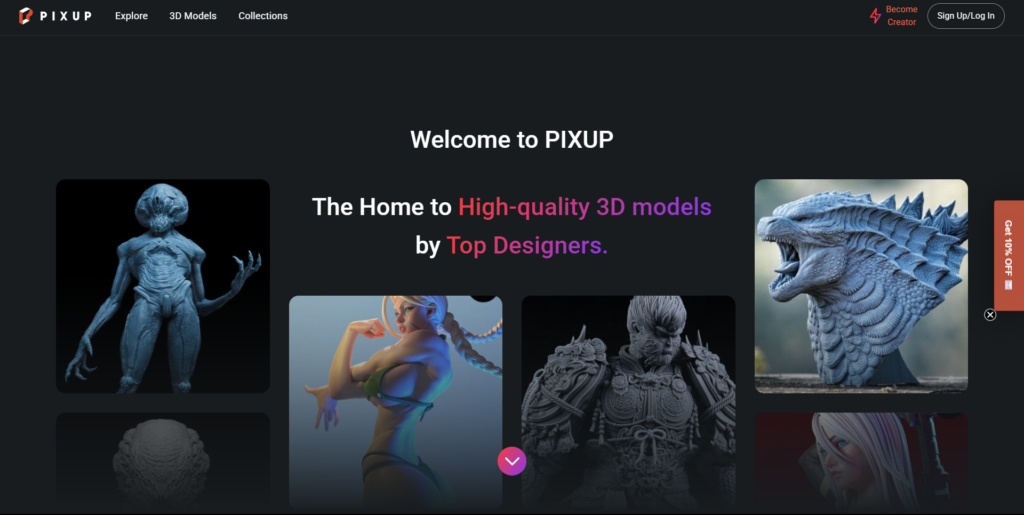
Image source: PIXUP
PIXUP is ideal for offering free and premium, well-tested paid STL files, ensuring buyers get reliable prints. Its Phrozen-Verified program guarantees models are print-ready, making them more attractive to customers. The platform prioritizes high-quality, trusted designs, giving verified creators better visibility and increasing their chances of making sales.
2. Cults3D
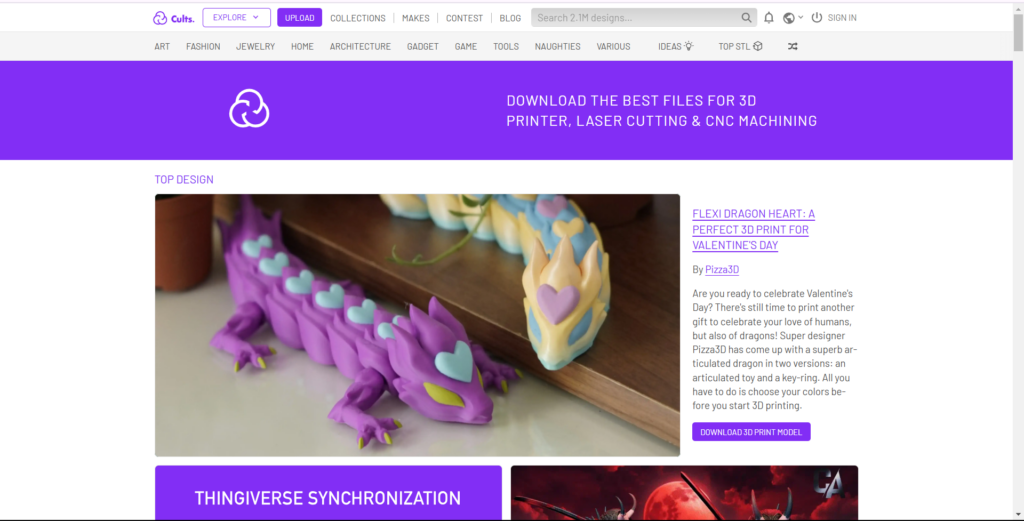
Image source: Cults3D
Cults3D is a popular marketplace for both free and paid STL files, attracting a large community of hobbyists and designers. Sellers can set their own prices, offer bulk purchase discounts, and list models in various formats, including STL, OBJ, and ZIP.
3. MyMiniFactory
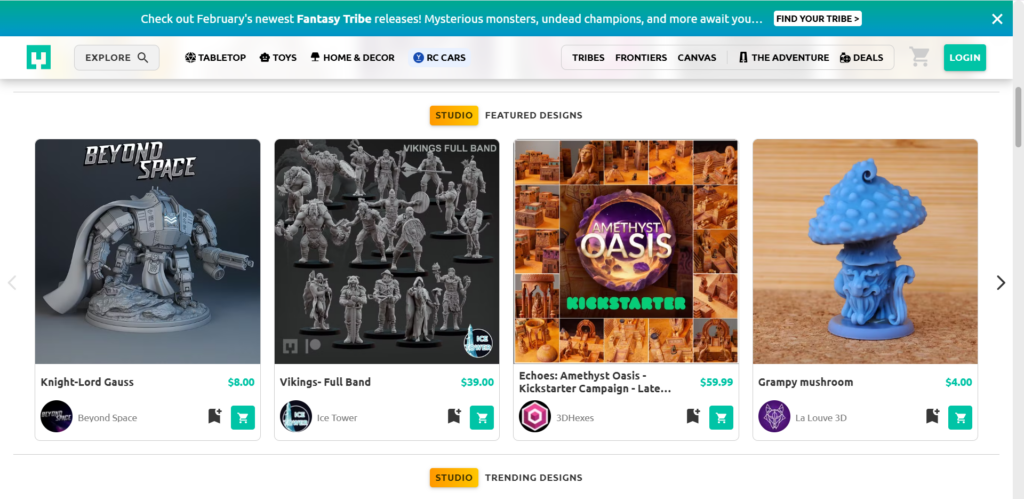
Image source: MyMiniFactory
MyMiniFactory is a thriving 3D printing marketplace known for its free and paid STL files, making it ideal for tabletop gaming, miniatures, and collectibles. The platform also offers Fabrique 3D for custom printing and crowdfunding options to help creators launch new projects, making it a great choice for designers looking to monetize their work and reach dedicated enthusiasts.
While these are the top platforms, consider diversifying your sales channels by selling through Etsy, Patreon, or your own website for additional income
Step 4. Optimize Your Product Listings for More Sales
Even the best-designed STL files won’t sell without proper presentation. To attract more buyers, optimize your product listings with:
A Compelling Title & Description. Use clear, keyword-rich titles like “Sci-Fi Space Marine Miniature – 32mm STL File for 3D Printing”. In the description, highlight size, supported versions, compatibility, and unique features.
High-Quality Renders & Print Examples. Include multiple angles, exploded views, and actual 3D print samples to build trust.
Keywords & Tags. Use relevant keywords so your STL files appear in marketplace searches (e.g., 3D printable miniature, 28mm STL, D&D terrain, cyberpunk armor).
Bundle or Discount Options. Offering STL file packs or special discounts encourages buyers to purchase more models at once.
Check out top-selling STL files on your chosen platform and analyze how they structure their listings to improve yours!
Step 5. Set Competitive Pricing for Your STL Files
Pricing your 3D model files correctly is key to maximizing profits. Overpricing can scare away buyers, while underpricing can devalue your work. Use this general pricing guide:
- Simple models (small props, accessories) → $3 – $10
- Tabletop gaming miniatures & terrain → $10 – $30
- Highly detailed, functional, or customizable models → $30+
Pro Tip: Sell STL file bundles at a slightly discounted price to encourage larger purchases and increase your overall earnings.
Step 6. Promote Your STL Files to Increase Sales
Selling STL files isn’t just about listing them—you also need to market your models to reach a wider audience. Here are some effective promotion strategies:
Leverage Social Media. Share renders, test prints, and behind-the-scenes content on Instagram, Facebook, and Reddit communities.
Engage in 3D Printing Forums. Websites like Reddit (r/3Dprinting), PIXUP, MyMiniFactory Tribes, and Cults3D comments help you connect with buyers.
Use YouTube & TikTok. Short videos showcasing your STL files in action can boost visibility.
Create a Patreon or Discord Community. Offer exclusive STL files to loyal followers who subscribe for monthly content.
Pro Tip: Running limited-time discounts or free downloads can attract new buyers and encourage repeat customers.
Selling STL Files Through Phrozen-Verified on PIXUP?
If you want higher credibility and better sales, PIXUP’s Phrozen-Verified program helps designers stand out by offering pre-tested, high-quality STL files.
Being Phrozen-Verified on PIXUP offers several advantages for sellers. Verified models gain more visibility by appearing in a trusted category, making them more appealing to buyers. Their proven printability reduces complaints and increases customer satisfaction, ensuring a smoother experience for both sellers and customers. Additionally, earning a verified badge helps creators build a strong reputation, giving them an edge over competitors selling untested files.
Want to get started? Apply for Phrozen-Verified and boost your sales with a trusted STL marketplace.
Things to Consider: Copyright & Legal Risks When Selling STL Files
One of the most important aspects of successfully selling STL files is ensuring your designs are 100% original and do not infringe on existing copyrights or trademarks.
Many designers unknowingly create models based on popular franchises, branded products, or fan art, which can result in DMCA takedowns, platform bans, or even legal action.
If you want to build a profitable, long-term business selling digital 3D models, focus on creating unique, high-quality designs that provide real value to customers while staying within legal boundaries.
Here’s what you need to know to sell STL files legally while protecting your business.
Prioritize Originality & Creativity
Selling STL files safely requires you to design unique models from scratch. Whether you’re creating tabletop miniatures, cosplay armor, functional household gadgets, or decorative items, originality is key to success.
Fully original designs protect you from copyright violations, ensuring no one can claim ownership of your work. Unique models also stand out in the marketplace, making them more attractive to buyers and increasing the likelihood of repeat customers.
Additionally, establishing a distinctive design style helps you build a recognizable brand, fostering trust and loyalty among customers.
Instead of making direct replicas of popular characters or props, consider designing “inspired-by” models with your own artistic twist to create something fresh, marketable, and legally safe. The more unique your designs, the more valuable and in demand they become!
Avoid Copyright & Trademark Violations
Many well-known characters, logos, and product designs are legally protected, meaning you cannot sell STL files based on them without permission. Common copyright violations include movie, anime, and video game characters such as Star Wars, Pokémon, and Marvel heroes.
Additionally, branded products and logos, including Nike sneakers, Apple devices, and Tesla cars, are protected under trademark laws. Even fan art models, regardless of modifications, still infringe on the original creator’s intellectual property. Selling these models can result in DMCA takedowns, bans, or legal action from rights holders.
If a design is instantly recognizable, assume it cannot be legally sold.
Check Licensing Terms for Any Assets You Use
If you modify existing 3D models, ensure they come from safe, legal sources with the appropriate licensing for commercial use. Public domain models with CC0 licenses are safe for resale, while Creative Commons files with commercial rights can be used, but always check the specific terms. The best and safest option is to create your own original work, eliminating any risk of copyright violations.
Warning: Many free STL files found on Thingiverse, Cults3D, and similar sites are for personal use only, meaning you cannot legally sell prints or modified versions. Always verify licensing terms before selling.
To be successful in selling STL files, it’s essential to create 100% original designs that set you apart from the competition. Avoiding trademarked or copyrighted content is crucial to protect your business from potential legal issues, including DMCA takedowns or account bans.
Additionally, always check licensing terms before modifying or reselling any 3D models to ensure you have the right to use them commercially. By focusing on originality and legal compliance, you can build a sustainable and profitable STL file business
Conclusion: Start Selling STL Files & Build Your Digital 3D Business
Selling STL files is one of the best ways to turn your 3D modeling skills into a scalable, passive income stream. Unlike selling physical 3D prints, it eliminates production costs, failed prints, and shipping hassles, allowing you to focus on creating and selling digital designs.
Whether you’re passionate about tabletop miniatures, cosplay props, or functional household gadgets, there’s a growing market for high-quality STL files.
To succeed, prioritize originality and creativity—unique designs not only stand out in the marketplace but also protect you from copyright issues. Avoid selling trademarked or copyrighted content, and always verify licensing terms before modifying or reselling any 3D models.
Choosing the right STL marketplace, optimizing your product listings, and actively promoting your designs will help you grow your sales and reach more customers.
Now is the perfect time to sell STL files and start earning from your 3D creations. Ready to get started? Join PIXUP today and turn your designs into a profitable business!
🎨 Phrozen Verified: Print Stunning, High-Detail Models with Ease!
Tired of failed prints and endless support adjustments? Phrozen Verified models are expertly pre-supported and optimized for hassle-free 3D printing. Skip the setup, hit print, and get stunning, high-detail 3D prints with zero stress. Explore the collection now and bring your models to life with ease! 🚀🔥

